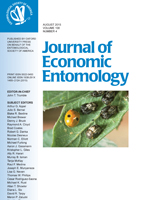The diamondback moth, Plutella xylostella (L.), is considered one of the most damaging lepidopteran pests, and it has developed resistance to all conventional insecticide classes in the field. Chlorantraniliprole is the first commercial insecticide that belongs to the new chemical class of diamide insecticides. But, P. xylostella have already shown resistance to chlorantraniliprole in China. After 52 generations of selection with chlorantraniliprole, ∼48.17-fold resistance was observed. The resistant strain showed cross-resistance to flubendiamide (7.29-fold), abamectin (6.11-fold), and cyantraniliprole (3.31-fold). Quantitative real-time polymerase chain reaction analysis showed that the expression of the ryanodine receptor gene was higher in the resistant strain than that in the susceptible strain. Enzyme assays indicated that cytochrome P450 activity in the resistant strain was 4.26 times higher compared with the susceptible strain, whereas no difference was seen for glutathione-S-transferase and esterase. Moreover, the toxicity of chlorantraniliprole in the resistant strain could be synergized by piperonyl butoxide, but not by diethyl maleate, and S,S,S-tributyl phosphorothioate. These results can serve as an important base for guiding the use of insecticide in field and delaying the development of pests that are resistant to the insecticides.
How to translate text using browser tools
1 August 2015
Resistance Selection and Characterization of Chlorantraniliprole Resistance in Plutella xylostella (Lepidoptera: Plutellidae)
Xia Liu,
Hong-Yan Wang,
Yu-Bo Ning,
Kang Qiao,
Kai-Yun Wang
ACCESS THE FULL ARTICLE
It is not available for individual sale.
This article is only available to subscribers.
It is not available for individual sale.
It is not available for individual sale.

Journal of Economic Entomology
Vol. 108 • No. 4
August 2015
Vol. 108 • No. 4
August 2015
chlorantraniliprole
Plutella xylostella
resistance mechanism
ryanodine receptor




